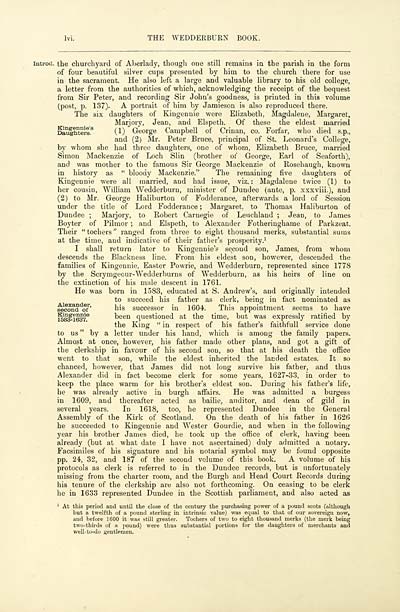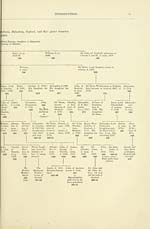Wedderburn book > History
(64) Page lvi
Download files
Complete book:
Individual page:
Thumbnail gallery: Grid view | List view

lvi. THE WEDDERBURN BOOK.
introd. the churchyard of Aberlady, though one still remains in the parish in the form
of four beautiful silver cups presented by him to the church there for use
in the sacrament. He also left a large and valuable library to his old college,
a letter from the authorities of which, acknowledging the receipt of the bequest
from Sir Peter, and recording Sir John's goodness, is printed in this volume
(post, p. 137). A portrait of him by Jamieson is also reproduced there.
The six daughters of Kingennie were Elizabeth, Magdalene, Margaret,
Marjory, Jean, and Elspeth. Of these the eldest married
Daughters? C 1 ) George Campbell of Crinan, co. Forfar, who died s.p.,
and (2) Mr. Peter Bruce, principal of St. Leonard's College,
by whom she had three daughters, one of whom, Elizabeth Bruce, married
Simon Mackenzie of Loch Slin (brother of George, Earl of Seaforth),
and was mother to the famous Sir George Mackenzie of Rosehaugh, known
in history as " bloody Mackenzie." The remaining five daughters of
Kingennie were all married, and had issue, viz. : Magdalene twice (1) to
her cousin, William Wedderburn, minister of Dundee (ante, p. xxxviii.), and
(2) to Mr. George Haliburton of Fodderance, afterwards a lord of Session
under the title of Lord Fodderance ; Margaret, to Thomas Haliburton of
Dundee ; Marjory, to Robert Carnegie of Leuchlaud ; Jean, to James
Boyter of Pilmor ; and Elspeth, to Alexander Fotheringhame of Parkzeat.
Their "tochers" ranged from three to eight thousand merks, substantial sums
at the time, and indicative of their father's prosperity. 1
I shall return later to Kingennie's second son, James, from whom
descends the Blackness line. From his eldest son, however, descended the
families of Kingennie, Easter Powrie, and Wedderburn, represented since 1778
by the Scrymgeour-Wedderburns of Wedderburn, as his heirs of line on
the extinction of his male descent in 1761.
He was born in 1583, educated at S. Andrew's, and originally intended
to succeed his father as clerk, being in fact nominated as
second o?' his successor in 1604. This appointment seems to have
168^1637° been questioned at the time, but was expressly ratified by
the King " in respect of his father's faithfull service done
to us " by a letter under his hand, which is among the family papers.
Almost at once, however, his father made other plans, and got a gift of
the clerkship in favour of his second son, so that at his death the office
went to that son, while the eldest inherited the landed estates. It so
chanced, however, that James did not long survive his father, and thus
Alexander did in fact become clerk for some years, 1627-33, in order to
keep the place warm for his brother's eldest son. During his father's life,
he was already active in burgh affairs. He was admitted a burgess
in 1609, and thereafter acted as bailie, auditor, and dean of gild in
several years. In 1618, too, he represented Dundee in the General
Assembly of the Kirk of Scotland. On the death of his father in 1626
he succeeded 1o Kingennie and Wester Gourdie, and when in the following
year his brother James died, he took up the office of clerk, having been
already (but at what date I have not ascertained) duly admitted a notary.
Facsimiles of his signature and his notarial symbol may be found opposite
pp. 24, 32, and 187 of the second volume of this book. A volume of his
protocols as clerk is referred to in the Dundee records, but is unfortunately
missing from the charter room, and the Burgh and Head Court Records during
his tenure of the clerkship are also not forthcoming. On ceasing to be clerk
he in 1633 represented Dundee in the Scottish parliament, and also acted as
1 At this period and until the close of the century the purchasing power of a pound scots (although
but a twelfth of a pound sterling in intrinsic value) was equal to that of our sovereign now,
and before 1600 it was still greater. Tochers of two to eight thousand merks (the merk being
two-thirds of a pound) were thus substantial portions for the daughters of merchants and
well-to-do gentlemen.
introd. the churchyard of Aberlady, though one still remains in the parish in the form
of four beautiful silver cups presented by him to the church there for use
in the sacrament. He also left a large and valuable library to his old college,
a letter from the authorities of which, acknowledging the receipt of the bequest
from Sir Peter, and recording Sir John's goodness, is printed in this volume
(post, p. 137). A portrait of him by Jamieson is also reproduced there.
The six daughters of Kingennie were Elizabeth, Magdalene, Margaret,
Marjory, Jean, and Elspeth. Of these the eldest married
Daughters? C 1 ) George Campbell of Crinan, co. Forfar, who died s.p.,
and (2) Mr. Peter Bruce, principal of St. Leonard's College,
by whom she had three daughters, one of whom, Elizabeth Bruce, married
Simon Mackenzie of Loch Slin (brother of George, Earl of Seaforth),
and was mother to the famous Sir George Mackenzie of Rosehaugh, known
in history as " bloody Mackenzie." The remaining five daughters of
Kingennie were all married, and had issue, viz. : Magdalene twice (1) to
her cousin, William Wedderburn, minister of Dundee (ante, p. xxxviii.), and
(2) to Mr. George Haliburton of Fodderance, afterwards a lord of Session
under the title of Lord Fodderance ; Margaret, to Thomas Haliburton of
Dundee ; Marjory, to Robert Carnegie of Leuchlaud ; Jean, to James
Boyter of Pilmor ; and Elspeth, to Alexander Fotheringhame of Parkzeat.
Their "tochers" ranged from three to eight thousand merks, substantial sums
at the time, and indicative of their father's prosperity. 1
I shall return later to Kingennie's second son, James, from whom
descends the Blackness line. From his eldest son, however, descended the
families of Kingennie, Easter Powrie, and Wedderburn, represented since 1778
by the Scrymgeour-Wedderburns of Wedderburn, as his heirs of line on
the extinction of his male descent in 1761.
He was born in 1583, educated at S. Andrew's, and originally intended
to succeed his father as clerk, being in fact nominated as
second o?' his successor in 1604. This appointment seems to have
168^1637° been questioned at the time, but was expressly ratified by
the King " in respect of his father's faithfull service done
to us " by a letter under his hand, which is among the family papers.
Almost at once, however, his father made other plans, and got a gift of
the clerkship in favour of his second son, so that at his death the office
went to that son, while the eldest inherited the landed estates. It so
chanced, however, that James did not long survive his father, and thus
Alexander did in fact become clerk for some years, 1627-33, in order to
keep the place warm for his brother's eldest son. During his father's life,
he was already active in burgh affairs. He was admitted a burgess
in 1609, and thereafter acted as bailie, auditor, and dean of gild in
several years. In 1618, too, he represented Dundee in the General
Assembly of the Kirk of Scotland. On the death of his father in 1626
he succeeded 1o Kingennie and Wester Gourdie, and when in the following
year his brother James died, he took up the office of clerk, having been
already (but at what date I have not ascertained) duly admitted a notary.
Facsimiles of his signature and his notarial symbol may be found opposite
pp. 24, 32, and 187 of the second volume of this book. A volume of his
protocols as clerk is referred to in the Dundee records, but is unfortunately
missing from the charter room, and the Burgh and Head Court Records during
his tenure of the clerkship are also not forthcoming. On ceasing to be clerk
he in 1633 represented Dundee in the Scottish parliament, and also acted as
1 At this period and until the close of the century the purchasing power of a pound scots (although
but a twelfth of a pound sterling in intrinsic value) was equal to that of our sovereign now,
and before 1600 it was still greater. Tochers of two to eight thousand merks (the merk being
two-thirds of a pound) were thus substantial portions for the daughters of merchants and
well-to-do gentlemen.
Set display mode to:
![]() Universal Viewer |
Universal Viewer | ![]() Mirador |
Large image | Transcription
Mirador |
Large image | Transcription
Images and transcriptions on this page, including medium image downloads, may be used under the Creative Commons Attribution 4.0 International Licence unless otherwise stated. ![]()
| Histories of Scottish families > Wedderburn book > History > (64) Page lvi |
|---|
| Permanent URL | https://digital.nls.uk/95651487 |
|---|
| Attribution and copyright: |
|
|---|---|
| Description | A selection of almost 400 printed items relating to the history of Scottish families, mostly dating from the 19th and early 20th centuries. Includes memoirs, genealogies and clan histories, with a few produced by emigrant families. The earliest family history goes back to AD 916. |
|---|

